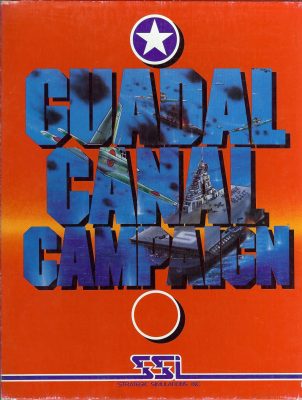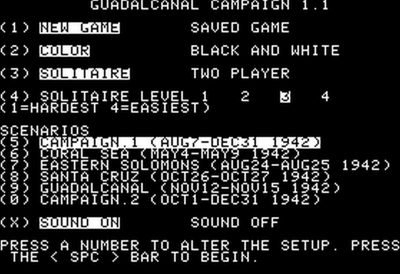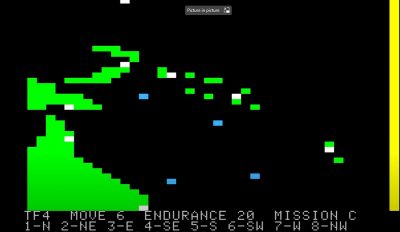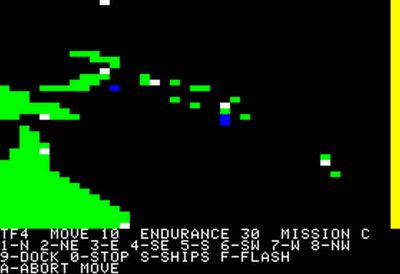Guadalcanal Campaign: A Retrospective on the First Monster Game for Personal Computer
 “Before Guadalcanal, the enemy advanced at his pleasure—after Guadalcanal, he retreated at ours.” – Adm. William F. (Bull) Halsey, USN
“Before Guadalcanal, the enemy advanced at his pleasure—after Guadalcanal, he retreated at ours.” – Adm. William F. (Bull) Halsey, USN
By Patrick S. Baker
In 1982, Strategic Simulations, Inc (SSI) released Guadalcanal Campaign (GC). The game is the first game developed by famed game designer, Gary Grigsby. GC is also considered the first commercially released “monster wargame” for personal computers.
In 1982, Grigsby was a civil servant working for the Department of Defense (DoD). He had long had an interest in strategy and wargame, buying and playing board games from companies like Avalon Hill, Victory Games, and Simulations Publications, Inc. (SPI).
In 1979, Grisby bought a TRS-80 to “take the combat systems off of these really complicated … wargames and put them on the computer.” Eventually, Grigsby was trying to develop and program full games using BASIC. But he had no idea how to contact the two main PC game developers of the time, SSI and Avalon Hill, to get his games produced and marketed.
After purchasing SSI’s Torpedo Fire, Grigsby called the company’s helpline to complain about a bug in the program. Random chance favored Grigsby as Joel Billings, founder and president of SSI, was manning the phones that day. After Billings helped Grigsby fix the bug, Grigsby mentioned that he designed computer games and asked if Billings would be interested in seeing them. Billings told Grigsby that SSI got over “75% of their games from independent designers” and they would “be glad to look at any of the games” Grigsby had programmed. Thinking that SSI would be most interested in his Guadalcanal game, Grigsby submitted it first. Billingsly quickly greenlit the game that would become GC for further development.
The idea for GC came from Grigsby and a friend struggling to play SPI’s Solomon’s Campaign. According to Grigsby the rules were “confusing” and the bookkeeping “tedious”, but the idea of a game that included the “interaction” of ground, air, surface, and submarine units was “fascinating”. Also, Grigsby knew that a computer version of the game could allow for great detail in describing the units involved, while at the same time “solving all of the rules and bookkeeping hassles.”
 Grigsby took about six months to fully develop the game while continuing to work his day job at the DoD. This work arrangement was “incredible hard” according to Grigsby. The largest changes he made to his original submission were to “switch over to hi-res graphics”, and to add a “solitaire capability” which required an artificial intelligence program that Grigsby called “Guadabrain”. Lastly, SSI added a “short” campaign scenario to the game, which ran from 1 October to 31 December 1942. Grigsby applied SSI’s usual rigorous standards to researching the game. This included using Japanese language sources for the Japanese order of battle.
Grigsby took about six months to fully develop the game while continuing to work his day job at the DoD. This work arrangement was “incredible hard” according to Grigsby. The largest changes he made to his original submission were to “switch over to hi-res graphics”, and to add a “solitaire capability” which required an artificial intelligence program that Grigsby called “Guadabrain”. Lastly, SSI added a “short” campaign scenario to the game, which ran from 1 October to 31 December 1942. Grigsby applied SSI’s usual rigorous standards to researching the game. This included using Japanese language sources for the Japanese order of battle.
 Even before it was released the video-gaming press was declaring GC the first “monster wargame for the computer.” In terms of board games, “monster games” are either very large, with 1,000 pieces, or more, “in play” at once, or are very complex, or both. Further, the “monster game” classification generally refers to the kind of wargames that require a vast amount of time to play and has a high level of historical accuracy and military realism. GC certainly meets those criteria of being a “monster game”. “Every ship, plane, and infantry company involved” in the campaign is represented. For example, the game has 293 ships, all of which were detailed as to arrival date, speed, survivability, and firepower. Also, a full game can take as long as 294 turns. GC being a computer game addressed many of the issues of playing such “monster games”, such as saving the game for further play, taking care of the detailed book and rules-keeping requirements, and needing no more space than the PC itself.
Even before it was released the video-gaming press was declaring GC the first “monster wargame for the computer.” In terms of board games, “monster games” are either very large, with 1,000 pieces, or more, “in play” at once, or are very complex, or both. Further, the “monster game” classification generally refers to the kind of wargames that require a vast amount of time to play and has a high level of historical accuracy and military realism. GC certainly meets those criteria of being a “monster game”. “Every ship, plane, and infantry company involved” in the campaign is represented. For example, the game has 293 ships, all of which were detailed as to arrival date, speed, survivability, and firepower. Also, a full game can take as long as 294 turns. GC being a computer game addressed many of the issues of playing such “monster games”, such as saving the game for further play, taking care of the detailed book and rules-keeping requirements, and needing no more space than the PC itself.
 GC is a turn-based game about the 1942 Battle of Guadalcanal in the Pacific during World War II. In the game the player commands the American land, sea, and air forces from 7 August to 31 December 1942 opposing the Americans are the Imperial Japanese forces, controlled by either a second human player or the computer. There are four shorter campaigns included as well.
GC is a turn-based game about the 1942 Battle of Guadalcanal in the Pacific during World War II. In the game the player commands the American land, sea, and air forces from 7 August to 31 December 1942 opposing the Americans are the Imperial Japanese forces, controlled by either a second human player or the computer. There are four shorter campaigns included as well.
 The map is a 40 x 40 grid stretching from Truk to the northern Australian shore, with key ports and airbases shown. GC also included a separate paper map for the player’s use. Each game turn represents 12 hours, two turns per day, the full campaign lasts 147 days. Each game turn involves reinforcing the troops, moving the naval task forces, which can include ships from transports to destroyers to aircraft carriers, getting the ground units into position, launching air missions, and then combat resolution. Victory points are calculated at the end of the scenario.
The map is a 40 x 40 grid stretching from Truk to the northern Australian shore, with key ports and airbases shown. GC also included a separate paper map for the player’s use. Each game turn represents 12 hours, two turns per day, the full campaign lasts 147 days. Each game turn involves reinforcing the troops, moving the naval task forces, which can include ships from transports to destroyers to aircraft carriers, getting the ground units into position, launching air missions, and then combat resolution. Victory points are calculated at the end of the scenario.
 GC was well received upon release. The game sold some 3,500 copies, which is very good for such a “niche” game, and also considering its hefty $60 dollar price tag in 1982 (more than $190 dollars in 2023 money).
GC was well received upon release. The game sold some 3,500 copies, which is very good for such a “niche” game, and also considering its hefty $60 dollar price tag in 1982 (more than $190 dollars in 2023 money).
The game was also well-reviewed in both the English and French speaking game press. Computer Gaming World’s review said: ” … Guadalcanal Campaign is the best historical simulation (and one of their best games) from SSI to date.” Plus, it is “a game that will keep you at your computer for days at a time.” Games Magazine called GC “outstanding” and “very playable despite its large scale.” Video Games magazine said GC “one of the best simulations available…” The French magazine Tilt said it was: “A very good wargame, well done and varied.” Casus Belli, another French publication, said it “is a game to recommend to all fans of naval conflict, particularly those interested in operations in the Pacific.”
Guadalcanal Campaign has an impressive legacy as well. The game set the standard for the many monster games to come, particularly from SSI and Gary Grigsby. The game also helped to establish both SSI and Gary Grigsby in the top tier of the gaming industry. In 2001, Grigsby along with SSI’s founders, Joel Billings and Keith Brors, went on to found 2 by 3 Games, where they continue to produce award-winning games, monster games such as Gary Grigsby’s War in the West and War in the East mainly focused on World War Two.
Patrick S. Baker is a former US Army Field Artillery officer and retired Department of Defense employee. He has degrees in History, Political Science, and Education. He has been writing history, game reviews, and science-fiction professionally since 2013. Some of his other work can be found at Sirius Science Fiction, Sci-Phi Journal, Armchair General, and Historynet.com
Sources:
Casus Belli (April 1983) Guadalcanal Campaign
Computer Gaming World (May-June 1982) “Hobby and Industry News”
Computer Gaming Word (Sept-Oct 1982) Guadalcanal Campaign: Review and Notes
Computer Gaming World (Nov-Dec 1982) “The History of a Wargame Design”
GAMES Magazine #46 (Dec 1983) Wargames
Mobygames.com Guadalcanal Campaign
Palmer, Nicholas, The Comprehensive Guide to Board Wargaming (New York: McGraw-Hill Book Company, 1977)
_________, The Best of Board Wargaming, (London: Arthur Barker, Ltd, 1980)
TheWargamer.com (16 Jul 2003) “Interview: Joel Billings and Gary Grigsby”
Tilt Magazine (March 1985) Guadalcanal Campaign
Video Games (October 1983) Wargames
